| Contents
Home
General
Info
Ordering
Info
Contact us
Cartridge
Lists
Patent & Miscellaneous
Rim Fire
Center Fire Pistol
Center Fire Rifle
Metric Rimfire,
Pistol&Rifle
British Pistol and Rifle
Shotgun Shells
Cartridge Boxes &
Related
Posters
This Month's Picture Page
Index to
Picture Pages
Prior Picture Pages:
*
September 2003
*
October 2003
*
November 2003
*
December 2003
*
January 2004
*
February 2004
*
March 2004
*
April 2004
*
May 2004
*
June 2004
*
July 2004
*
August 2004
*
September 2004
*
October 2004
*
November 2004
*
December
2004
*
January 2005
*
February
2005
*
March
2005
*
April
2005
*
May 2005
* June 2005
* July 2005
*
August 2005
*
September
2005
*
October 2005
*
November 2005
*
December 2005
*
January 2006
*
February 2006
*
March 2006
*
April 2006
*May 2006
*June 2006
*July 2006
*August
2006
*September
2006
*October
2006
*November
2006
*December
2006
*January
2007
*February
2007
*March
2007
*April
2007
*May
2007
*June
2007
*July
2007
*August
2007
*September
2007
*October
2007
*November
2007
*December
2007
*January
2008
*February
2008
*March
2008
*April
2008
*May
2008
*June
2008
*July
2008
*August
2008
Links to Other Sites
Cartridge Collectors Organizations:
IAA
ECRA
SAAACA
Auctions:
Auction
Arms
E-Bay
Ward's Collectibles
Sold USA
Books:
Armory
Publications
WCF Publications
Other Collector's Sites:
Curtis Steinhauer
|
Home of the Old Ammo Guy's Virtual
Cartridge Trading Table
Featuring a wide range of antique,
obsolete, and modern ammunition for collectors
Picture
Page
September 2008
A very uncommon .32 S&W cartridge........
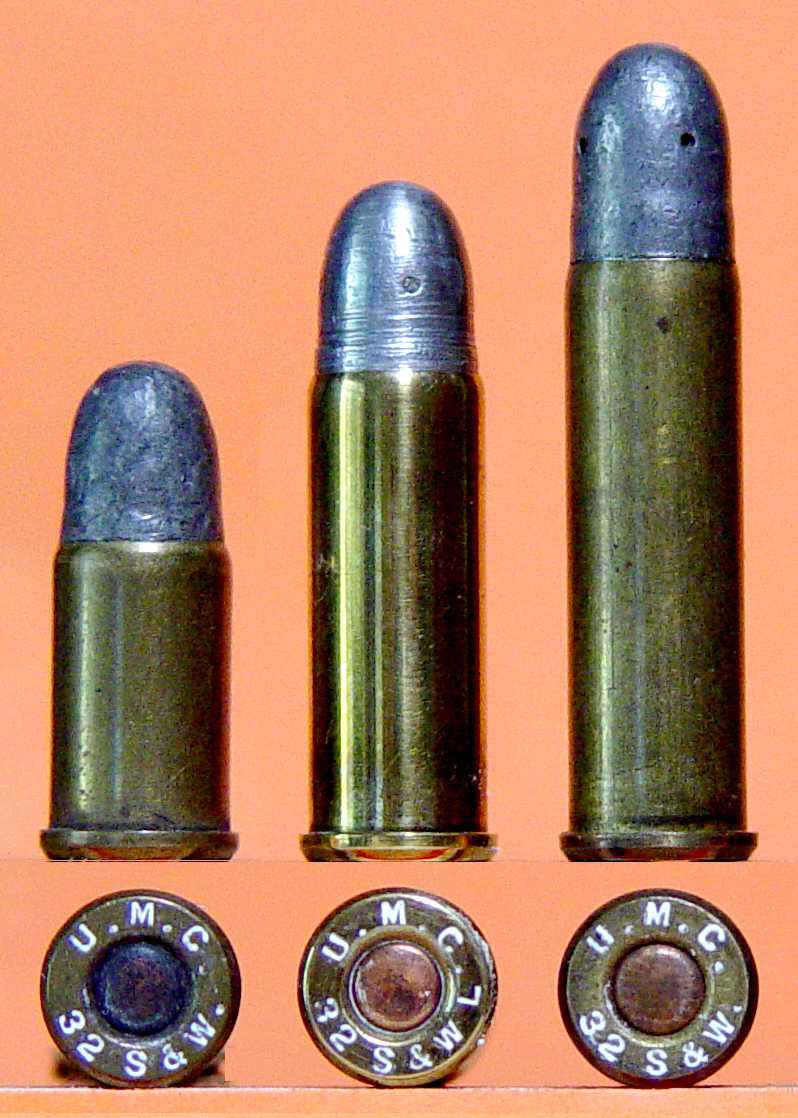
The .32 S&W is one of the more common cartridges available to collectors,
but on occasion, the .32 S&W headstamp will show up where it is least
expected. The cartridge on the right in this picture with its magnum length
case and self-lubricated bullet is one example. Most of us were first
exposed to this cartridge in Charles Suydam's book U.S. Cartridges
and Their Handguns; he dubbed it the .32 Special. He speculated that
this cartridge may have been produced around 1899 as one of a series of
improved cartridges produced for Smith & Wesson by UMC in .32, .38, .41, and
.44 caliber, from which evolved the .38 Special and perhaps the .44 Special.
There also exists a very rare cartridge with a U.M.C.
41 S&W. headstamp and an inside lubricated bullet which was considered
by Suydam have been the .41 'Special' contender in the Smith & Wesson foursome of beefed up cartridges.
.
.
And a very uncommon cartridge loading
tool........
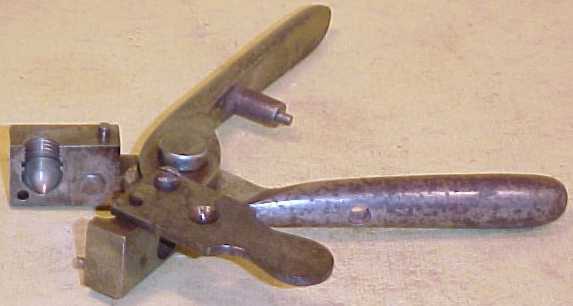
This rather substantial tool is for loading the 12mm French Galand 'reloadable'
cartridge. It performs some of the same basic functions in the same manner
as many of the other scissors style loading tools, including de-priming the
fired case, re-priming it, and casting a new bullet. The left picture below
shows the de-priming plunger on one handle and the hole that allows the
spent primer to fall out of the way on the other handle. The picture on the
right shows the hole in one side of the mold block that holds the cartridge
case in position for re-priming. A flat raised area on the other mold block,
seen in the
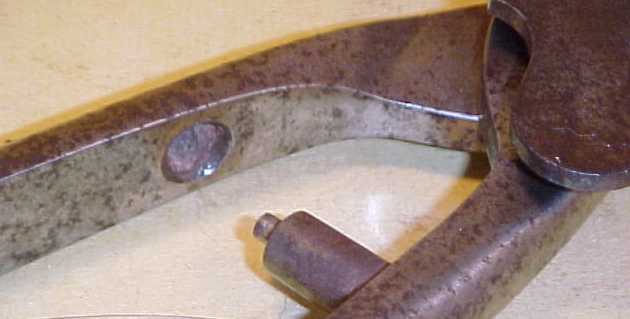 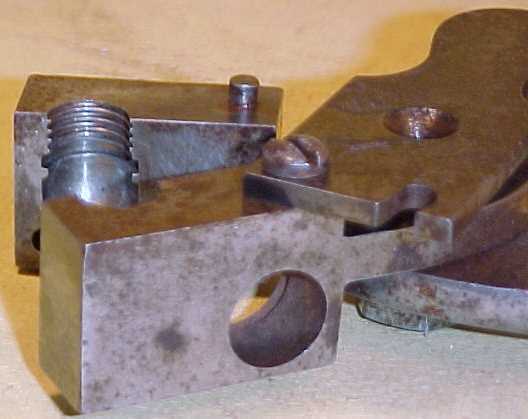 upper
picture to the right of the bullet cavity, presses the new battery style
primer in place in the case. Two functions that this tool does not perform
are seating the bullet and crimping the case neck. The reason these
functions have been omitted is that they are not necessary for loading the
cartridge the tool was designed for. What I assume to be a unique
characteristic of this type of tool is that it casts a bullet that is
intended to be screwed into the cartridge case. This close-up picture below
of the mold cavity shows that it produces a 'heel-type' bullet with what on
first glance might appear to be grooves upper
picture to the right of the bullet cavity, presses the new battery style
primer in place in the case. Two functions that this tool does not perform
are seating the bullet and crimping the case neck. The reason these
functions have been omitted is that they are not necessary for loading the
cartridge the tool was designed for. What I assume to be a unique
characteristic of this type of tool is that it casts a bullet that is
intended to be screwed into the cartridge case. This close-up picture below
of the mold cavity shows that it produces a 'heel-type' bullet with what on
first glance might appear to be grooves
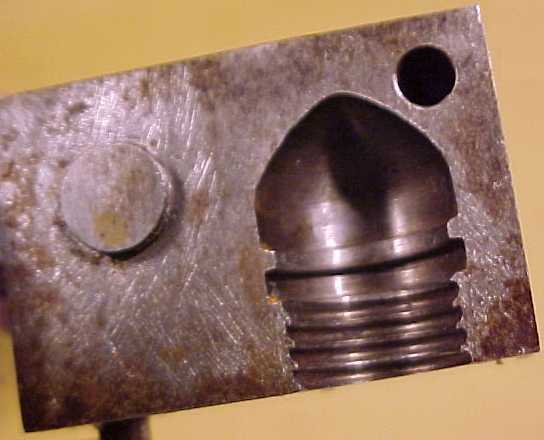 around
its heeled portion. However, closer examination will reveal that these
grooves are actually angled to form a right-hand thread (as in righty-tighty,
lefty-loosey). The cartridge case, described by the maker as indestructible,
had a thick wall with a matching thread in the mouth to receive the bullet.
On firing, the bullet threads were intended to be sheared off. It is evident
from the cavity that the leading edge of the threads is angled towards the
nose of the bullet; I suspect this is to ensure that the sheared off lead
remains in place in the mouth of the case rather than being deposited in the
barrel where it might cause problems with succeeding. Shortly after
obtaining this tool, I heard from someone who had around
its heeled portion. However, closer examination will reveal that these
grooves are actually angled to form a right-hand thread (as in righty-tighty,
lefty-loosey). The cartridge case, described by the maker as indestructible,
had a thick wall with a matching thread in the mouth to receive the bullet.
On firing, the bullet threads were intended to be sheared off. It is evident
from the cavity that the leading edge of the threads is angled towards the
nose of the bullet; I suspect this is to ensure that the sheared off lead
remains in place in the mouth of the case rather than being deposited in the
barrel where it might cause problems with succeeding. Shortly after
obtaining this tool, I heard from someone who had
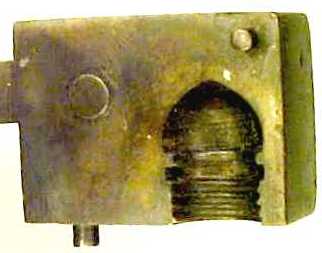 found a similar tool at
a gun show earlier in the year. Pictures that he provided revealed that the
two tools differed most notably in the shape of the head of the bolt that
holds the two halves together, and in the size of the stud that presses the
new primer in place, his being significantly smaller than mine. I can only
surmise that the size of this stud was related to the size of the primers
the tool was intended to be used with; more on this in just a moment. found a similar tool at
a gun show earlier in the year. Pictures that he provided revealed that the
two tools differed most notably in the shape of the head of the bolt that
holds the two halves together, and in the size of the stud that presses the
new primer in place, his being significantly smaller than mine. I can only
surmise that the size of this stud was related to the size of the primers
the tool was intended to be used with; more on this in just a moment.
.
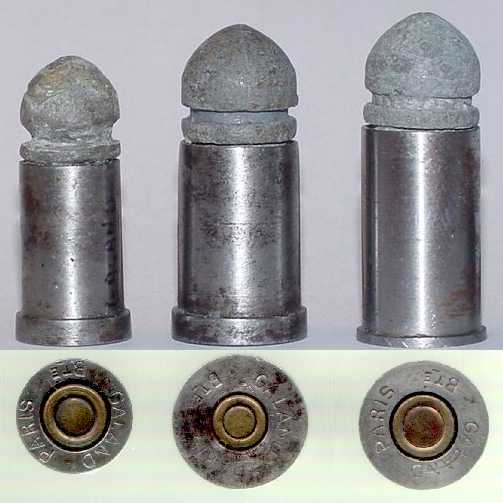 Here's
a picture of three Galand 'reloadable' cartridges that was provided by a
French collector. The one
on the left a 9mm, and the other two are both 12mm showing the thick and
thin rimmed versions of the iron cases and two sizes of the battery-style
primer that was used in the earlier cartridges. Later cartridges will be
found with what I believe are Berdan primers, about the same size as the
smaller battery-style primer. I can only surmise that it was the evolution
of the primer that was responsible for the change in the size of the
primer-seating stud on the tools, as noted above, with the smaller studs
being adopted as the primers made the change from the large battery-style to
the smaller battery-style, and then to the Berdan. The headstamp on all
three of these cartridges is GALAND PARIS BTE. I have found a
copy of the patent, nor anything else definitive regarding when the Galand 'reloadable
cartridges were first introduced, but I would guess it was in the early
1870s. Here's
a picture of three Galand 'reloadable' cartridges that was provided by a
French collector. The one
on the left a 9mm, and the other two are both 12mm showing the thick and
thin rimmed versions of the iron cases and two sizes of the battery-style
primer that was used in the earlier cartridges. Later cartridges will be
found with what I believe are Berdan primers, about the same size as the
smaller battery-style primer. I can only surmise that it was the evolution
of the primer that was responsible for the change in the size of the
primer-seating stud on the tools, as noted above, with the smaller studs
being adopted as the primers made the change from the large battery-style to
the smaller battery-style, and then to the Berdan. The headstamp on all
three of these cartridges is GALAND PARIS BTE. I have found a
copy of the patent, nor anything else definitive regarding when the Galand 'reloadable
cartridges were first introduced, but I would guess it was in the early
1870s.
.
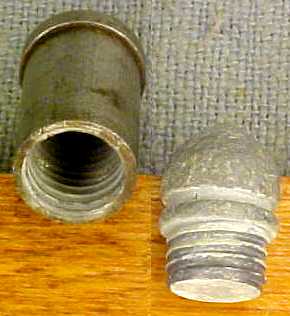 This
next picture looks down inside one of these thick-rimmed iron 12 mm cases,
and clearly shows the threads in the mouth of the case, into which the base
of the bullet is screwed. This
next picture looks down inside one of these thick-rimmed iron 12 mm cases,
and clearly shows the threads in the mouth of the case, into which the base
of the bullet is screwed.
.
.
.
Here is an illustration of the Galand reloading tool taken from an 1879
French publication; except for the mold cavity that is obviously not
depicted correctly, the tool in the drawing is a very close copy of the actual
tool.
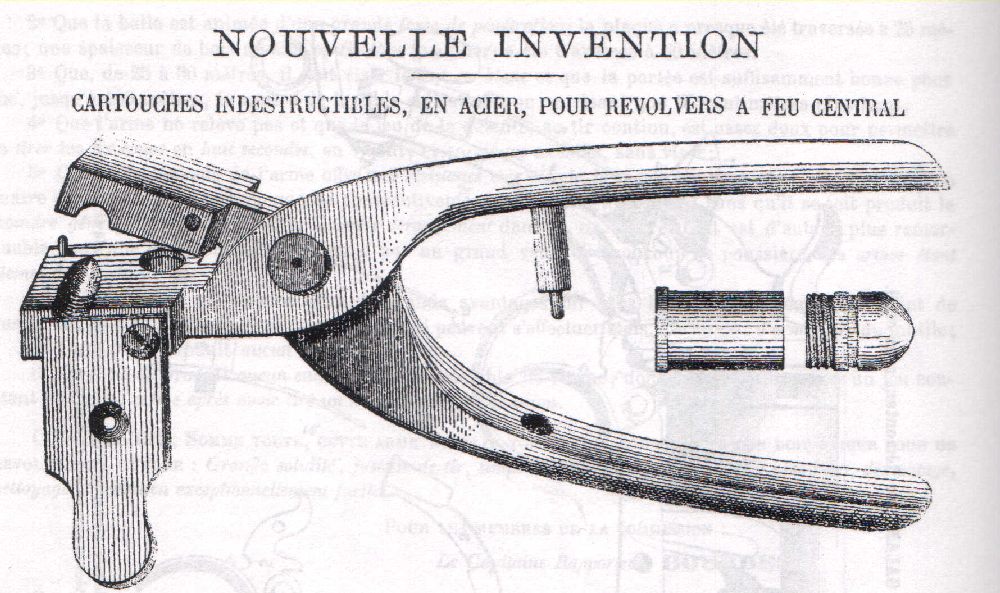
.
.
.
.
.
.
.
.
.
.
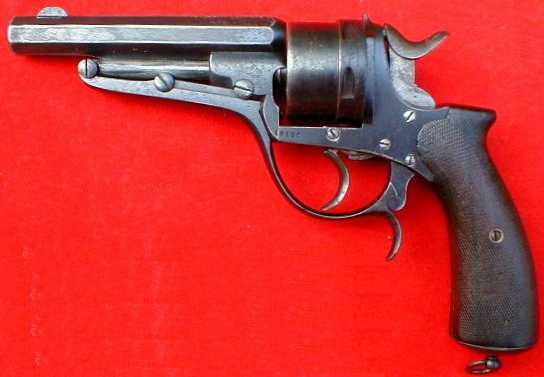 A
Galand 12mm revolver. A
Galand 12mm revolver.
.
.
.
.
.
.
.
.
.
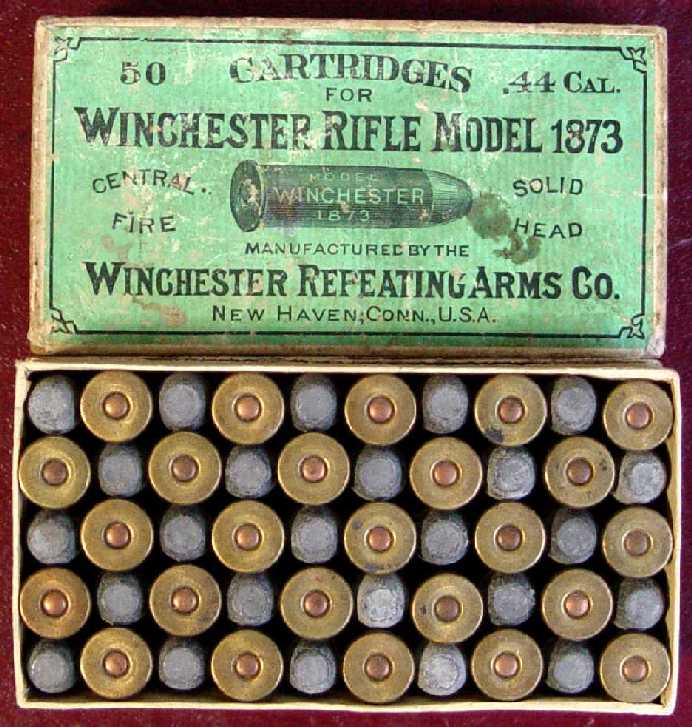
|



 upper
picture to the right of the bullet cavity, presses the new battery style
primer in place in the case. Two functions that this tool does not perform
are seating the bullet and crimping the case neck. The reason these
functions have been omitted is that they are not necessary for loading the
cartridge the tool was designed for. What I assume to be a unique
characteristic of this type of tool is that it casts a bullet that is
intended to be screwed into the cartridge case. This close-up picture below
of the mold cavity shows that it produces a 'heel-type' bullet with what on
first glance might appear to be grooves
upper
picture to the right of the bullet cavity, presses the new battery style
primer in place in the case. Two functions that this tool does not perform
are seating the bullet and crimping the case neck. The reason these
functions have been omitted is that they are not necessary for loading the
cartridge the tool was designed for. What I assume to be a unique
characteristic of this type of tool is that it casts a bullet that is
intended to be screwed into the cartridge case. This close-up picture below
of the mold cavity shows that it produces a 'heel-type' bullet with what on
first glance might appear to be grooves
 around
its heeled portion. However, closer examination will reveal that these
grooves are actually angled to form a right-hand thread (as in righty-tighty,
lefty-loosey). The cartridge case, described by the maker as indestructible,
had a thick wall with a matching thread in the mouth to receive the bullet.
On firing, the bullet threads were intended to be sheared off. It is evident
from the cavity that the leading edge of the threads is angled towards the
nose of the bullet; I suspect this is to ensure that the sheared off lead
remains in place in the mouth of the case rather than being deposited in the
barrel where it might cause problems with succeeding. Shortly after
obtaining this tool, I heard from someone who had
around
its heeled portion. However, closer examination will reveal that these
grooves are actually angled to form a right-hand thread (as in righty-tighty,
lefty-loosey). The cartridge case, described by the maker as indestructible,
had a thick wall with a matching thread in the mouth to receive the bullet.
On firing, the bullet threads were intended to be sheared off. It is evident
from the cavity that the leading edge of the threads is angled towards the
nose of the bullet; I suspect this is to ensure that the sheared off lead
remains in place in the mouth of the case rather than being deposited in the
barrel where it might cause problems with succeeding. Shortly after
obtaining this tool, I heard from someone who had
 found a similar tool at
a gun show earlier in the year. Pictures that he provided revealed that the
two tools differed most notably in the shape of the head of the bolt that
holds the two halves together, and in the size of the stud that presses the
new primer in place, his being significantly smaller than mine. I can only
surmise that the size of this stud was related to the size of the primers
the tool was intended to be used with; more on this in just a moment.
found a similar tool at
a gun show earlier in the year. Pictures that he provided revealed that the
two tools differed most notably in the shape of the head of the bolt that
holds the two halves together, and in the size of the stud that presses the
new primer in place, his being significantly smaller than mine. I can only
surmise that the size of this stud was related to the size of the primers
the tool was intended to be used with; more on this in just a moment.  Here's
a picture of three Galand 'reloadable' cartridges that was provided by a
French collector. The one
on the left a 9mm, and the other two are both 12mm showing the thick and
thin rimmed versions of the iron cases and two sizes of the battery-style
primer that was used in the earlier cartridges. Later cartridges will be
found with what I believe are Berdan primers, about the same size as the
smaller battery-style primer. I can only surmise that it was the evolution
of the primer that was responsible for the change in the size of the
primer-seating stud on the tools, as noted above, with the smaller studs
being adopted as the primers made the change from the large battery-style to
the smaller battery-style, and then to the Berdan. The headstamp on all
three of these cartridges is GALAND PARIS BTE. I have found a
copy of the patent, nor anything else definitive regarding when the Galand 'reloadable
cartridges were first introduced, but I would guess it was in the early
1870s.
Here's
a picture of three Galand 'reloadable' cartridges that was provided by a
French collector. The one
on the left a 9mm, and the other two are both 12mm showing the thick and
thin rimmed versions of the iron cases and two sizes of the battery-style
primer that was used in the earlier cartridges. Later cartridges will be
found with what I believe are Berdan primers, about the same size as the
smaller battery-style primer. I can only surmise that it was the evolution
of the primer that was responsible for the change in the size of the
primer-seating stud on the tools, as noted above, with the smaller studs
being adopted as the primers made the change from the large battery-style to
the smaller battery-style, and then to the Berdan. The headstamp on all
three of these cartridges is GALAND PARIS BTE. I have found a
copy of the patent, nor anything else definitive regarding when the Galand 'reloadable
cartridges were first introduced, but I would guess it was in the early
1870s.  This
next picture looks down inside one of these thick-rimmed iron 12 mm cases,
and clearly shows the threads in the mouth of the case, into which the base
of the bullet is screwed.
This
next picture looks down inside one of these thick-rimmed iron 12 mm cases,
and clearly shows the threads in the mouth of the case, into which the base
of the bullet is screwed.
 A
Galand 12mm revolver.
A
Galand 12mm revolver.